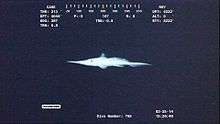Rhinochimaeridae
The Rhinochimaeridae, commonly known as long-nosed chimaeras,[2] are a family of cartilaginous fish. They are similar in form and habits to other chimaeras, but have an exceptionally long conical or paddle-shaped snout. The snout has numerous sensory nerve endings, and is used to find food such as small fish.[3] The first dorsal fin includes a mildly venomous spine, used in defense.[1]
| Rhinochimaeridae | |
|---|---|
.gif) | |
| Narrownose chimaera (Harriotta raleighana) | |
| Scientific classification | |
| Kingdom: | Animalia |
| Phylum: | Chordata |
| Class: | Chondrichthyes |
| Order: | Chimaeriformes |
| Family: | Rhinochimaeridae Garman, 1901 |
| Genera | |
Long-nosed chimaeras are found in temperate and tropical seas worldwide, from 200 to 2,000 m (660 to 6,560 ft) in depth.[1] They range from 60 to 140 cm (2.0 to 4.6 ft) in maximum total length, depending on species.

Rhinochimaeridae in the Gulf of Mexico at roughly 4300 ft deep
Species
The eight known species are in three genera:[1]
Family Rhinochimaeridae
- Genus Harriotta Goode & Bean, 1895
- Harriotta haeckeli Karrer, 1972 (smallspine spookfish)
- Harriotta raleighana Goode & Bean, 1895 (narrownose chimaera)

Pacific longnose chimaera, Harriotta raleighana
- Genus Neoharriotta Bigelow & Schroeder, 1950
- Neoharriotta carri Bullis & J. S. Carpenter, 1966 (dwarf sicklefin chimaera)
- Neoharriotta pinnata Schnakenbeck, 1931 (sicklefin chimaera)
- Neoharriotta pumila Didier & Stehmann, 1996 (Arabian sicklefin chimaera)
- Genus Rhinochimaera Garman, 1901
- Rhinochimaera africana Compagno, Stehmann & Ebert, 1990 (paddlenose chimaera)
- Rhinochimaera atlantica Holt & Byrne, 1909 (broadnose chimaera)
- Rhinochimaera pacifica Mitsukuri, 1895 (Pacific spookfish)
gollark: Why not?
gollark: If an OS needs a GUI, then do headless Linux distros not count as OSes?
gollark: Just use some random OSes on the forums then.
gollark: <@490656381662396418> There are already decent ones around. You do not have the experience/skills to make another good one and it would be a bit pointless anyway. Instead, you will add another trashy "OS" to the pile of 400 or so existing ones.
gollark: You have to download it, convert to DFPWM, and write that to a tape.
References
- Froese, Rainer, and Daniel Pauly, eds. (2009). "Rhinochimaeridae" in FishBase. January 2009 version.
- CBC News: Creepy deepwater fish surprises Nova Scotia fisherman
- Stevens, H. & Last, P.R. (1998). Paxton, J.R. & Eschmeyer, W.N. (eds.). Encyclopedia of Fishes. San Diego: Academic Press. p. 69. ISBN 0-12-547665-5.
External links
| Wikispecies has information related to Rhinochimaeridae |
- Froese, Rainer, and Daniel Pauly, eds. (2011). "Rhinochimaeridae" in FishBase. 2 2011 version.
This article is issued from Wikipedia. The text is licensed under Creative Commons - Attribution - Sharealike. Additional terms may apply for the media files.